Triennials Out of Time: Singapore Biennale and Hawaiʻi Triennial
Binna Choi and Drew Kahuʻāina Broderick
October 2023
Triennials Out of Time is a series of short conversations featuring artistic directors and curators of cyclical exhibitions organized by James McAnally for the Counterpublic 2023 civic exhibition. Across disparate forms, Triennials Out of Time considers whether the slow build and release of multi-year, cyclical exhibitions may offer a more humane pace that allows proper engagement, inquiry, and reorientation to one’s place and publics.
In this sixth conversion, Binna Choi, co-artistic director of Singapore Biennale 2022: natasha (October 16, 2022 to March 19, 2023), speaks with Drew Kahuʻāina Broderick, a participating artist in the Singapore Biennale 2022 and co-curator of Hawaiʻi Triennial 2022: Pacific Century – E Hoʻomau no Moananuiākea (February 18 to May 8, 2022). This reflection on both natasha and Pacific Century is an edited transcript of a recording made on the night of April 15, 2023, in the lobby of the Kaimana Beach Hotel, Waikīkī, Oʻahu, Hawaiʻi, during a visit by the curatorial team of the upcoming Hawaiʻi Triennial 2025, of which Choi is a member.
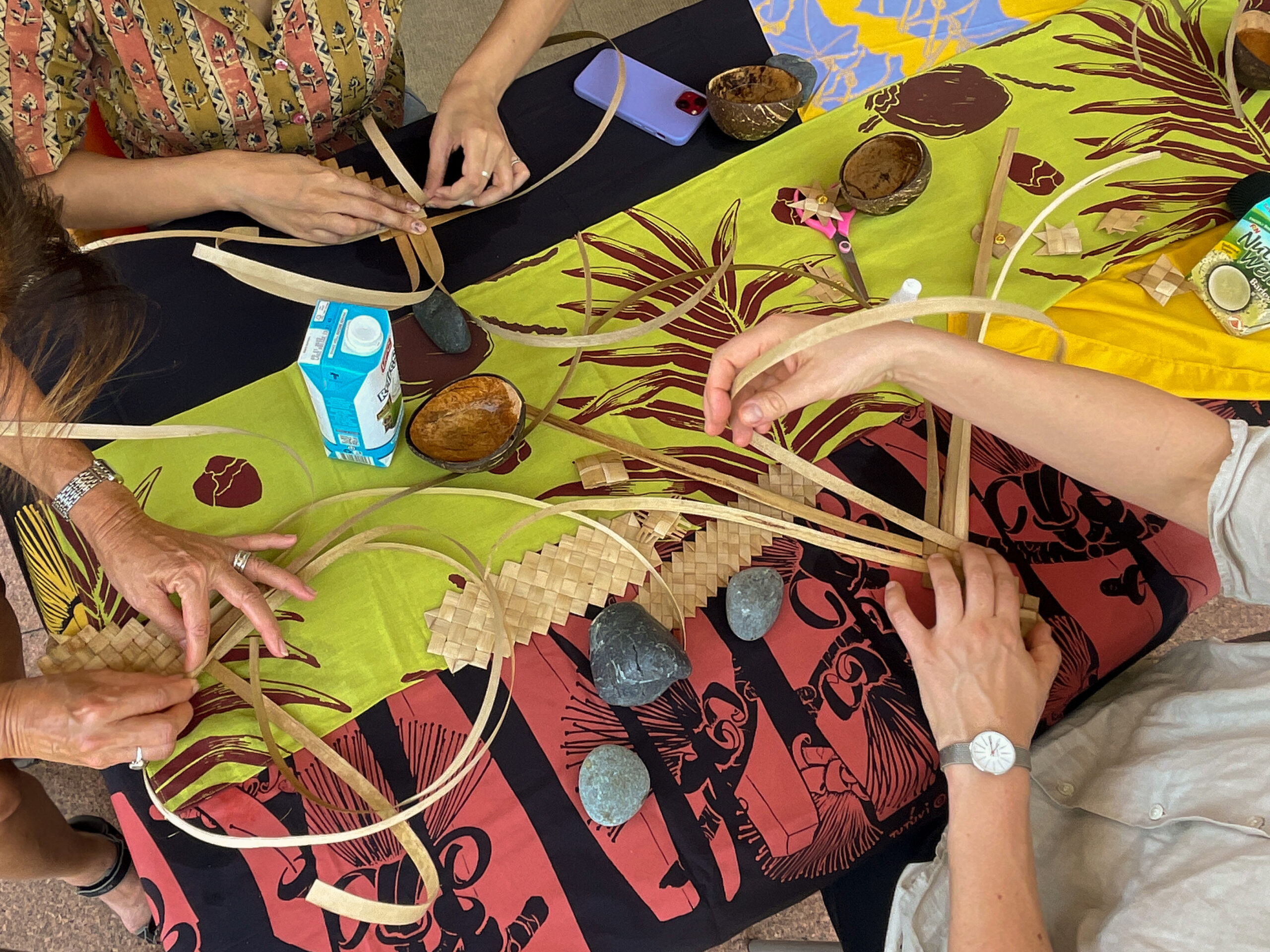
here and there, a three-part public program including “Māka Puke | Bookmark,” a weaving workshop led by Sancia Miala Shiba Nash of KEANAHALA for KĪPUKA [for “Natasha”], a place-responsive installation organized by Maile Meyer and Drew Kahuʻāina Broderick, Sentosa Cove, 2022. Singapore Biennale 2022 curated by June Yap, Nida Ghouse, Ala Younis, and Binna Choi. Photo: Drew Kahuʻāina Broderick
Drew Kahuʻāina Broderick: Don’t feel sorry, Binna! The global biennial/triennial circuit is what it is. All we can do is participate (or not) in ways that are aligned with our beliefs, when and where we feel compelled to. I’m still amazed that it all came together in the ways that it did, especially given the limited institutional support for international travel by participating artists. It was the first time Mom and I collaborated on a project of this scale, so it was important to us to be present in place, if only momentarily, at some point during the Biennale. As you know, we learned a lot from one another as the project KĪPUKA [for “Natasha”] took shape, and we learned even more during the closing week of the Biennale when we organized a three-part public program, here and there, at Sentosa Cove on Sentosa Island. In a lot of ways, the weaving workshop facilitated by Sancia and my Mom as representatives of KEANAHALA (a Hawaiʻi-based community-oriented weaving initiative); a panel discussion with Singapore-based curator Fang-Tze Hsu and educator George Radics, moderated by writer Wong Binghao; and poetry reading led by Oʻahu-based poet and filmmaker Richard Hamasaki, were a way for us to give back to natasha, to the administrative and curatorial teams, to the Biennale participants, and to the spaces and places that supported the event.
BC: So, you’re not so disappointed by the experience? You know, I was somehow nervous about your visit, feeling unsure whether the Biennale could fulfill all the labor you have to put into the trip, especially before being immersed myself in the closing weekend – as a curator from outside who has been at a physical and mental distance from the Biennale for a while.
DKB: No. No disappointment at all. Only gratitude. I try not to have any expectations when collaborating on projects like this; otherwise, we prematurely limit our potential experiences. That said, I do remain curious about what could have happened if there were more participating artists, working groups, collaboratives, and collectives present throughout SB22.
BC: I appreciate that, and I learned a lot from your determination to come, connect with people here, and join other activities, too. Being present together will be kept as a kind of absolute criterion for me from now on. In fact, it’s something that Maria Lind, one of the senior curators from whom I learned a lot of fundamental aspects of curating, valued and advocated for against any circumstances.
DKB: Wouldn’t want it any other way. Presence is how we affirm and establish relationships. In this way, the artwork is secondary.
BC: Yes! This way, we also can moderate the scale of a biennial or triennial and make it people-centered. The scale can be as large as it wants to be, as long as it can enable people to come together – so it’s not about the mere number.
What about the location at Sentosa Cove? How do you feel that your contribution, KĪPUKA [for “Natasha”], was situated there? It’s an island resort residential zone that looks like a place only for a few, although in reality it’s not. While it’s disconnected or even isolated from the everyday work/life reality of most people, it is a point of connection as it’s the location to take a ferry to the Southern Islands, one of many natasha locations, which is disconnected.
DKB: My mother and her sisters, my aunties, often remind me that we are always in relation. We know this because we are of Hawaiʻi, one of many archipelagos in the “sea of islands” that is Oceania. In spite of any perceived disconnects between KĪPUKA [for “Natasha”], Sentosa Cove, and the rest of natasha, what mattered to us was that the shipping container-cum-VISITOR CENTRE occupied space as a testament to relationality, and not to an individual artist, artwork, or story.
In ʻŌlelo Hawaiʻi, Hawaiian language, the word kīpuka carries many meanings that allude to the importance of difference and regeneration: “variation or change of form, as a calm place in a high sea, deep place in a shoal, opening in a forest, openings in cloud formations, and especially a clear place or oasis within a lava bed where there may be vegetation.”1 KĪPUKA [for “Natasha”] was a way for us to gather together and share an eclectic mix of materials from an intergenerational group of family, friends, and frequent collaborators in a context that they may not otherwise have. For ʻĪmaikalani Kalāhele, Wayne Kaumualii Westlake, Protect Kahoʻolawe ʻOhana, ʻElepaio Press, Nā Maka o ka ʻĀina, Tutuví, ʻAi Pōhaku Press, Native Books, Nā Mea Hawaiʻi, Lawrence Seward, Bradley Capello, KEANAHALA, and kekahi wahi, it was the first time that their work had been presented in Singapore, and for some, the first time their work had been shown outside of Hawaiʻi.
In regards to the Biennale itself, we were never interested in controlling where our work was positioned or how it was received. We trusted you completely and we loved hearing about all the moments of unexpected confusion and perhaps even clarity, when an unassuming visitor walked in searching for information about the place they were visiting and instead found themselves face-to-face with material from elsewhere. That’s what it’s all about.
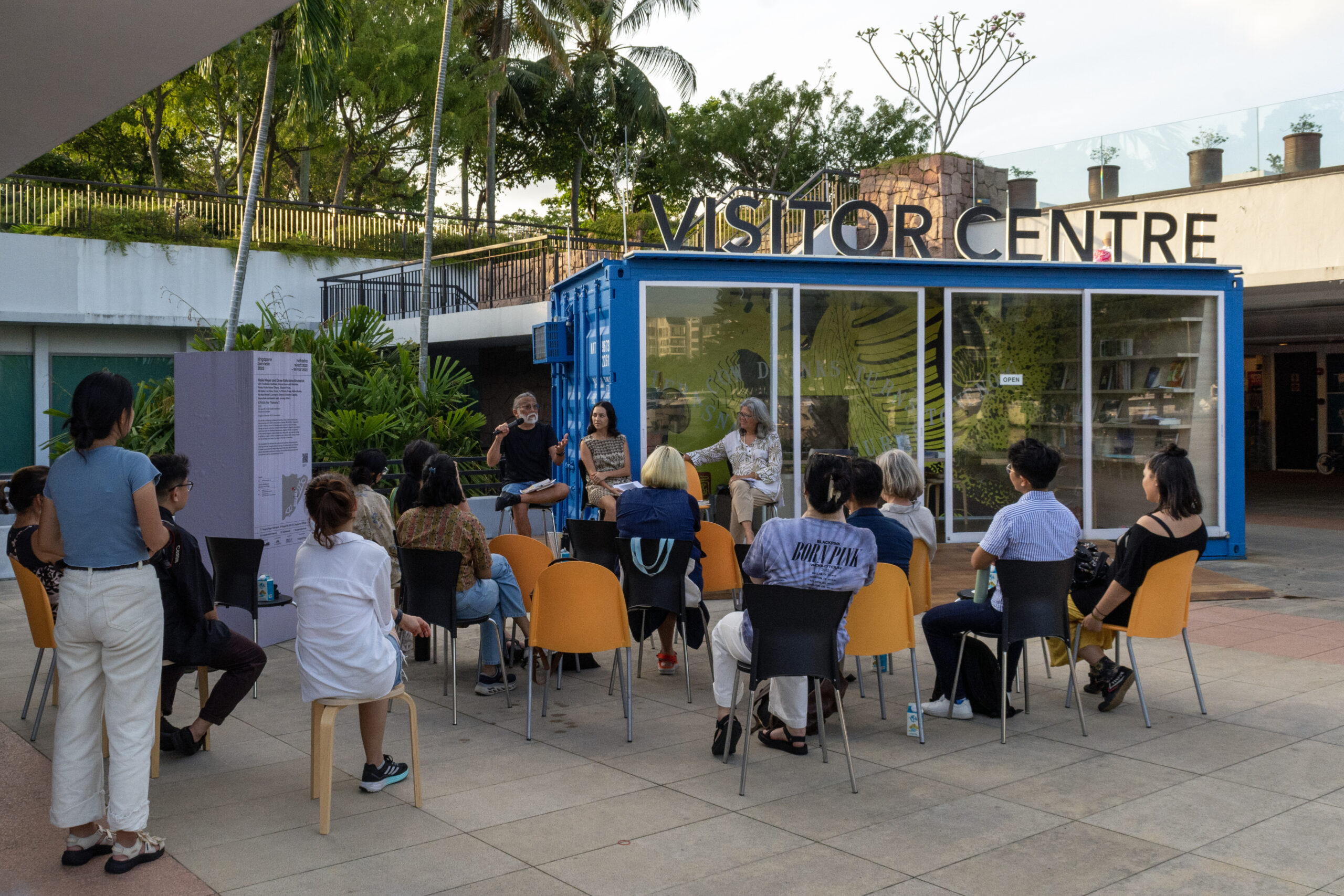
here and there, a three-part public program including “Afterlives, The Radical Possibilities of Friendship,” a poetry reading with Richard Hamasaki and friends for KĪPUKA [for “Natasha”], a place-responsive installation organized by Maile Meyer and Drew Kahuʻāina Broderick, Sentosa Cove, 2022. Singapore Biennale 2022, curated by June Yap, Nida Ghouse, Ala Younis, and Binna Choi. Photo: Drew Kahuʻāina Broderick
By the way, these questions of what is or isn’t within our control never go away. At times it’s difficult to diplomatically reconcile artists’ projects, a curatorial vision, and the aspirations of the entities behind a given biennial, whether it’s a foundation, institution, state, and/or nation. But there’s something similar across all these positions. You can’t know everything beforehand, especially as you attempt something new, but there are pressures to articulate what is taking shape – whereas the institutions in charge often have their habits in ways of working or thinking that remain unconscious and unchanged. And this becomes its own labor on all sides – an endless process of explaining, correcting, or being corrected over what the event could be beyond what it has been.
DKB: As someone who has only recently started participating in biennials and triennials, I still feel like the formats they impose have a lot of unrealized potential. Personally, it has been utterly exhausting at times to constantly advocate for a different way, but change can, and does, happen. When curating Hawaiʻi Triennial 2022: Pacific Century – E Hoʻomau no Moananuiākea (HT22) with Miwako Tezuka and Melissa Chiu, there were times when we, as a curatorial team, did not offer an explanation. It was important to us that Hawaiʻi Contemporary, the host organization presenting the triennial, trusted our choices and accepted a certain level of opacity. Related to this, I wonder how natasha’s coming into the world was influenced by the bureaucratic structure that facilitates public engagement with contemporary art in Singapore. Were you and your collaborators able to develop SB22 fully in the way that you wanted, or were certain aspects of natasha neglected along the way?
BC: It was only after a few online curatorial workshops among four of us (Ala Younis, Nida Ghoush, June Yap, and myself) that we magically arrived at this concept of naming the Biennale (instead of titling it) and engaging with all the major implications of it. It’s specific to humanity to name things, from the very colonial act of renaming native places to giving a friendly, common name to robots. Evoking such an aspect that defines being human, we were also interested in the existential question around the act of naming, including calling someone or something by a name. At the same time, we wanted to bring down this question to how an institution of art can be “more human” (or less human), situated in everyday fabric while providing a space for vulnerability and resilience, or having some soul.
The reason we chose Natasha, a fairly common female name, despite its association with its Slavic origin or being a rather “Western” name, has to do with the interest of exploring these questions together with the public – Who is Natasha, who is not, what and why? – as to become a question about the self. Yet, we gave ourselves quite an ambitious, if not risky, task with this orientation. It requires doing things differently in every major aspect of making a biennial – from ways of writing and forms of narrative in the press release, exhibition guide, wall texts, website, social media, and so on, to ways of staging artworks at this large scale and at multiple venues – in other words, choreography and scenography. Doing things differently meant that we had to elaborate in every instance while being creative, playful, intimate, detailed, and precise.
This very non-conventional approach requiring a certain degree of curatorial craft, however, did not have favorable conditions. The bureaucratic process is based on a lack of trust, and it takes a lot of energy away from the creative flow and down-to-earth mode of being and spending time together. That imposition was coupled with the incongruous, if not non-existent, protocol and misunderstandings between different outsourced bodies, companies, and individuals, each with their own different uses or desires of language and aesthetic sensibilities.
This problem stood out, especially as much of our preparatory time was in the middle of the pandemic, without physically meeting in person and on the ground. It was only toward the end of the Biennale period, when we were able to spend some time in Singapore interacting with each other without major restrictions, that some of us in the extended team felt attuned and closer. So, the best way of speaking of natasha might be that it is still growing, perhaps mature at some point, still changing and aging among us.
DKB: In a roundabout way, the act of naming, as opposed to titling, feels related to our earlier discussion of opacity, of refusing to provide an explanation for every curatorial decision. Let’s pivot from the position of a curator to that of an artist. As an artist, I sometimes prefer, depending on the context, to speak for myself – that is, to bypass a curator’s explanation of my practice and/or work. Did this concern come up at all for you folks during the making of SB22?
BC: During our earlier Zoom curatorial workshops, we were discussing our current pressing curatorial concerns as a method of developing a collective idea. One of the concerns we addressed is how our curatorial position is already mediated by our proximity to artists and their lives, which enables an intimate relationship to artworks without the need for didactic or explanatory information. It is a kind of privilege, which we are perhaps not fully aware of. Audiences do not have that. The question was how to facilitate the bridging of this gap and allow the audience/public to “meet” artists, however indirectly. One of the strategies we took is to use the exhibition guide for the artists’ own introduction to their practice, providing an aspect of the artist’s life beyond the explanation of the artworks exhibited. When you read, you feel closer to them. However, making this kind of guide is one thing, but how to distribute it well and make it accessible to the public is another.
DKB: Were there any unexpected or pleasantly surprising moments for you over the course of natasha?
BC: Li Li Chung, one of around fifty docents for natasha, was quite critical of us when we walked through the exhibition with her and other docents prior to the opening. She said: It’s not clear enough. When I came back to Singapore in the middle of the Biennale, Li Li and I were in the same audience for one of the public events. In the public discussion, she shared with the rest of the audience that of all the Singapore Biennale editions she has worked for, natasha was the most difficult one to guide; but after a while, it became the most thought-provoking one, and this speaks to the Singaporean tendency to over-identify and over-explain, reflected in the general identity politics. Then, after the event, she directly told me that however much natasha is criticized now or not, it will remain the most remembered edition for the Singaporean public.
DKB: How wonderful! Hopefully other Biennale-goers who felt similarly to Li Li were able to translate that feeling of not fully knowing or grasping to other aspects of their lives, beyond their relationships with art.
BC: Yeah, I was somewhat anxious about the perceived “difficulty” of natasha at first, but over time I realized that the difficulty can also be generative. After the opening, Yu-Jin Tay, one of the board members of the Biennale, texted me to share a conversation between him and his ten-year-old daughter Nicole, as proof of how the exhibition as named invites a special relationship. Nicole told her dad that she met natasha, but she’s not to be seen. It’s more like a secret or a ghost reproducing itself, coming in and out of her mind!
DKB: Hahaha, how fitting.
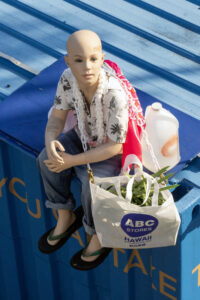
Bradley Capello, “natasha [from Hawaiʻi] (DEPARTURE)” for KĪPUKA [for “Natasha”], a place-responsive installation organized by Maile Meyer and Drew Kahuʻāina Broderick, Sentosa Cove, 2022. Singapore Biennale 2022, curated by June Yap, Nida Ghouse, Ala Younis, and Binna Choi. Photo: Drew Kahuʻāina Broderick
DKB: Do you remember the last time you were on the island and we hung out with Bradley Capello across the street at Kapiʻolani Park?
BC: Yeah.
DKB: Bradley and I have been collaborating together – making installations, retail environments, and parties – for almost ten years now. Youthful expression has always been a throughline for us, whether it’s sex, drugs, music, or fashion. natasha was a chance for us to celebrate youthfulness. We were actually sitting right over there at the bar when we came up with the idea for “natasha [from Hawaiʻi].” We have a beloved friend, her name is Madelyn Biven. Maddie is a dancer, choreographer, and performance artist. Bradley thought it would be interesting to come up with a series of four different looks for her – ARRIVAL, FORGETTING, REMEMBERING, DEPARTURE – and then transpose them onto the mannequin.
BC: Oh, that’s very singular and intimate, which I very much hoped would happen – what [Gayatri] Spivak refers to as the power of synecdoche for the ethics of being with others! So natasha as someone close to you and Bradley?
DKB: Yeah, that’s actually how we began our conversation about “natasha [from Hawaiʻi].” Bradley asked me what “Natashas” I knew and I asked him what “Natashas” he knew, and then we went from there as a way of getting to know a natasha that neither of us knew. At the time, we imagined Singapore and Hawaiʻi to be similar in many ways . . .
BC: Aren’t Singapore and Hawaiʻi very different?
DKB: Yes, but there are so many overlapping issues – the archipelagic realities of sea level rise, container shipping, militourism, capitalism (authoritarian or not), foreign desires . . .
BC: Hmm . . . I’m not so sure yet. I’m thinking of Singapore being very public as much of its infrastructure is top-down and government-led while Hawaiʻi . . .
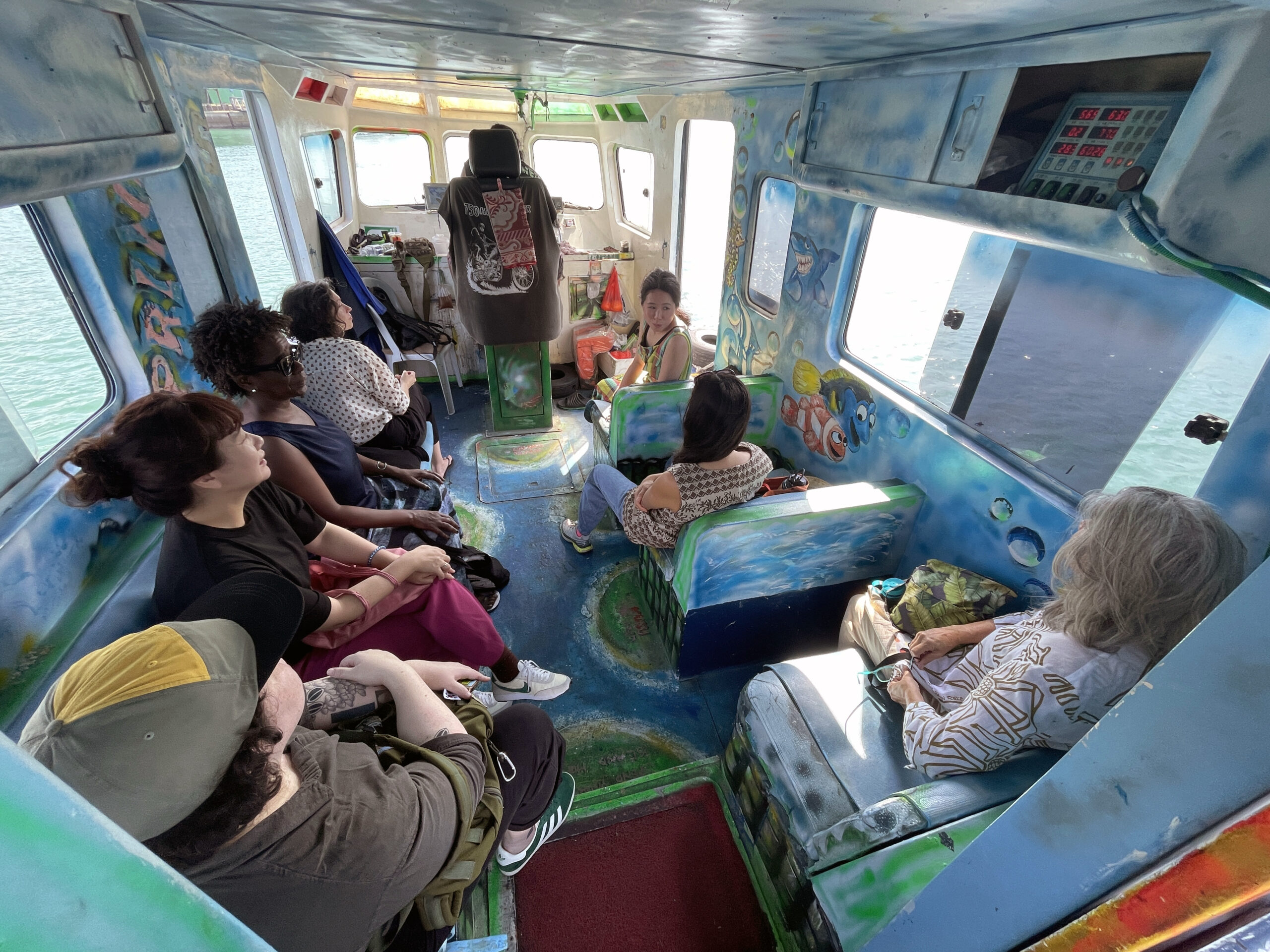
An international group en route to St. John’s Island and Lazarus Island, led by Binna Choi and Ala Younis as part of the closing events of natasha. Photo: Drew Kahuʻāina Broderick
DKB: Sure. Life in Hawaiʻi isn’t defined by authoritarian capitalism like it is in Singapore, but there were definitely moments during our visit when I experienced something that reminded me of home. I really felt it during the group visit that you and Ala Younis led to St. John’s Island and Lazarus Island – the local ferry boat, island resort, military flyovers, and international tourist industry. Regardless, I have a related question about disparity, about contradictions, that I’d like to get your thoughts on. When it comes to the long-term impact of biennials and triennials, do you believe that they have the capacity to leave the places in which they take place in a “better” position than before? Do these large-scale periodic events nurture growth, or do they leave a trail of devastation in their wake?
BC: I don’t think they’re as bad as the Olympics, if that’s what you mean.
DKB: Maybe. What I’m really trying to ask is: How do we make use of biennials and triennials to benefit Native and local communities of the place in which they are happening? How do we increase support for these communities and the places that sustain them, not just the high-profile artists or collectives from elsewhere who regularly participate in these global circuits?
BC: Well, you made it happen! I think that the HT22 exhibition at Hawaiʻi State Art Museum (HiSAM) empowered the art communities of Hawaiʻi. Through a tight assemblage of works from contemporary art to ephemera, publications, poems, film documentaries, and a reading room, you folks were able to remember and celebrate the role that Native/non-Native artist collaborations have played and continue to play in the movement for Hawaiian sovereignty and self-determination. At HiSAM, it was not just an individual that stood out, but the collectivity, in the same way that the installations were in relationship with one another, drawn together from a larger political and cultural movement.
The way you curated HT22 must have been enabled by the fact that you are an integral part of the arts communities of Hawaiʻi, as well as an artist in your own right. In terms of the latter, there’s a strong subjective shaping and knitting of different kinds of works with respect to the artists, authors, venues, and contexts, instead of treating each of them as isolated and distant individuals. Taken together, they offer an e/affective curatorial methodology.
DKB: Collaboration across different disciplines and environments is vital to the work I do as an artist, curator, educator, and writer. The HT22 exhibition at HiSAM and the essay I wrote to accompany it, “Native/non-Native Artist Collaborations Against U.S. Empire in Hawaiʻi,” were opportunities to utilize an internationally oriented, large-scale, periodic exhibition in service of family, friends, and frequent collaborators who have influenced my practice and many others over the years.2 In this sense, the motivations for saying “yes” to participating as a curator for HT22 were the same as saying “yes” to participating as an artist for SB22. No matter the situation, it’s about honoring relationships nurtured in, by, and through communities. And if this is a methodology, then it’s one that’s relevant beyond the curatorial field – it’s a way of being in relation.
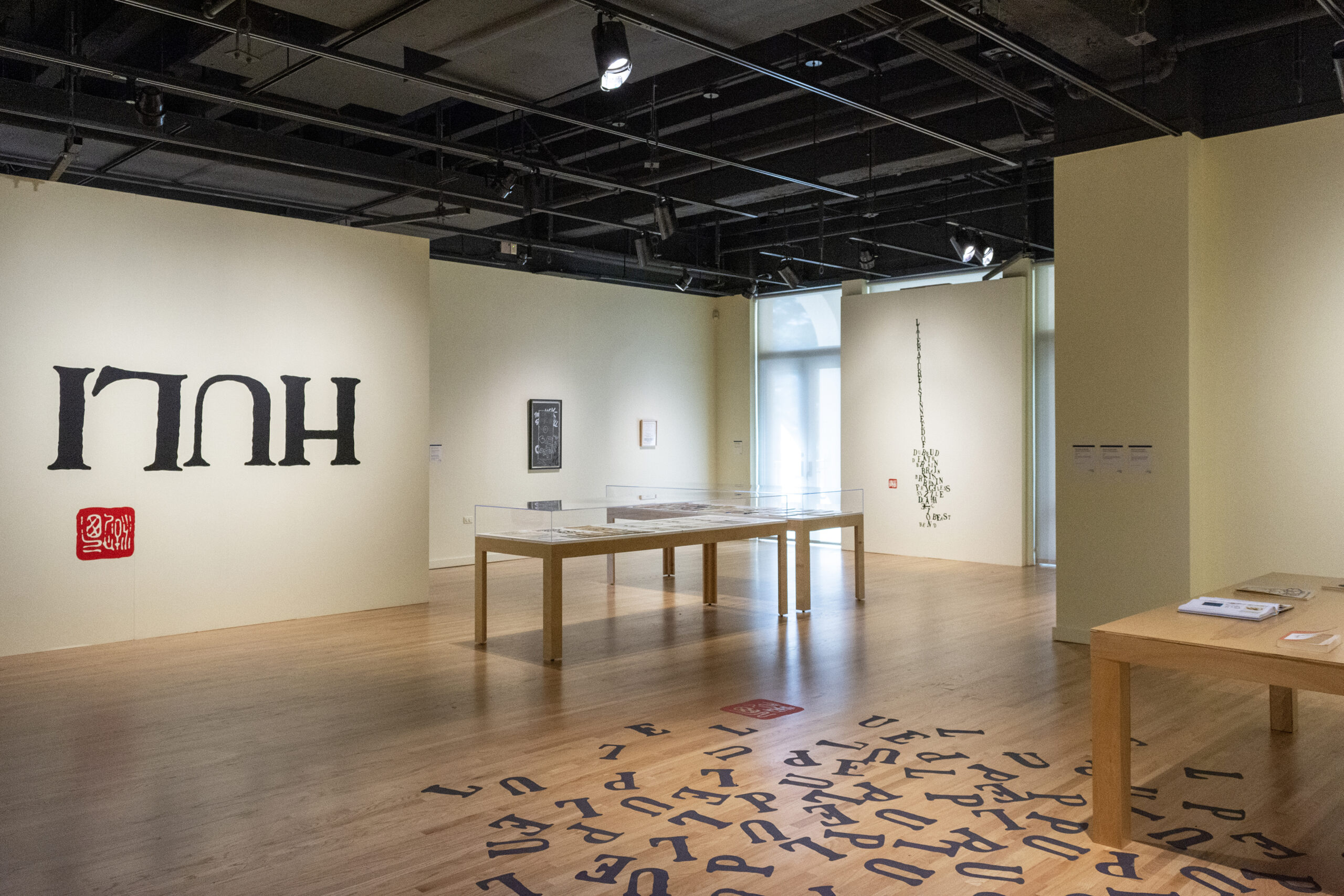
ʻElepaio Press (Richard and Mark Hamasaki), “In Memoriam Wayne Kaumualii Westlake (1947–1984),” 2022, Hawaiʻi State Art Museum, Hawaiʻi Triennial 2022: Pacific Century – E Hoʻomau no Moananuiākea, curated by Drew Kahuʻāina Broderick, Miwako Tezuka, and Melissa Chiu. Photo: Drew Kahuʻāina Broderick
Footnotes
- Mary Kawena Pukui and Samuel H. Elbert, “kīpuka,” Hawaiian Dictionary: Hawaiian-English English-Hawaiian (Honolulu: University of Hawaiʻi Press, 1971), 143.
- Drew Kahuʻāina Broderick, “E Ho‘omau no Moananuiākea: Native/non-Native Artist Collaborations Against U.S. Empire in Hawai‘i,” in Hawai‘i Triennial 2022: Pacific Century – Ho‘omau no Moananuiākea, ed. Melissa Chiu, Miwako Tezuka, and Drew Kahu‘āina Broderick (Honolulu: University of Hawai‘i Press, 2022), 37–57.
Binna Choi currently works as the curator for Hawaiʻi Triennial 2025. She has served as the director of Casco Art Institute: Working for the Commons (2008–2023), Utrecht, the Netherlands, where she is now the cooperative curatorial advisor. Under her direction, Casco has been exploring the commons as an alternative to binary worldviews and systems through and for art, taking it as its organizing principle. Choi served as co-artistic director for the Singapore Biennale 2022, named natasha, and as curator for the 11th Gwangju Biennale (2016), titled The Eighth Climate (What Does Art Do?), through which she reconnected with the land where she was born and grew up. Choi is also a member of the Akademie der Künste der Welt in Cologne, Germany.
Drew Kahuʻāina Broderick currently serves as director of Koa Gallery, Kapiʻolani Community College and is a member of kekahi wahi (2020–present), a grassroots film initiative documenting stories of transformation. Recently, he co-curated the inaugural Hawaiʻi Triennial: Pacific Century – E Hoʻomau no Moananuiākea (2022). His work as an artist, curator, and educator from Mōkapu, Koʻolaupoko, Oʻahu is guided by the efforts of Kānaka ʻŌiwi women – especially his mother, aunties, and maternal grandmother – who have devoted their lives to art, education, organizing, and community in Hawaiʻi.